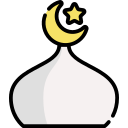
- Share to:
Historical Dictionary Of Buddhism
From Library JournalrnPrebish (religious studies, Pennsylvania State Univ.), the author of numerous titles on Buddhism, narrows his dictionary topics to significant persons, places, texts, events, doctrines, practices, and movements within the Buddhist tradition. While he focuses on monastic and sectarian traditions, his concise introduction includes Buddha's life, the foothold of Buddhism in India, and its spread via Emperor Asoka's missionaries. Overviews of the Pali, Chinese, and Tibetan canons augment his chronology and extensive bibliography. Capitalized headings can't reproduce every diacritical, but entries do. Referring readers from commonly spelled Tibetan terms to the transliterated headings would have been helpful, since they often begin with silent letters. In addition, there are a few debatable facts. For instance, Prebish states that Tsongkhapa was the uncle of the first Dalai Lama, though his real uncle was Geshe Choshe. Still, Prebish's coverage of over 2000 years of Buddhism, within a small, serviceable dictionary, is worthy of recommendation.rn- Dara Eklund, Los Angeles P.L.rnCopyright 1993 Reed Business Information, Inc.rnFrom BooklistrnThe history of humankind is inextricably linked to religion. That Buddhism is one of the oldest active religions makes it the perfect subject for the first volume in this series, Historical Dictionaries of Religions, Philosophies, and Movements, published by Scarecrow. The book is divided into three parts: a lengthy introduction, the dictionary itself, and an extensive bibliography.rnThe introductory material includes a pronunciation guide, a list of Buddhist scriptures from its various branches, a chronology of Buddhist history, and a map. The pronunciation guide clarifies the differences between Sanskrit and Pali, Chinese, Tibetan, and Japanese languages and their transliteration into English. The list of Buddhist scriptures is divided into the canons of the various cultures and branches of Buddhism. The five-page chronology covers the growth of Buddhism by century from 6 B.C. to the twentieth century. The author's introduction opens with a biography of Siddhartha Gautama, the Buddha, then expounds upon the information in the chronology and the scripture lists.rnrnThe dictionary itself has approximately 700 entries, each at least a paragraph in length; some take a whole page. Cross-references are noted parenthetically at the end of an entry in capital letters. Entries include westerners significant in Buddhism, such as Edward Conze and Caroline Rhys-Davids, as well as such Eastern Buddhists as the Dalai Lama and Nichiren; definitions of Buddhist terms and ideas: and important historical events such as the various councils and eras (e.g., T'ang Dynasty).rnrnThe bibliography contains almost 1,000 entries. These are arranged by subject: Historical Development; Texts in Translation; Religious Thought; Practices; Soteriology; Biography and Mythology; Sacred Places; The Social Order; and The Arts. Each category is subdivided by geographic area or idea. The vast majority are English titles; a few are in European languages.rnrnPrebish is a respected scholar of Buddhism and the history of early India. He has given us a remarkable reference tool that will be useful to both the religious and historical researcher and should be in most public and academic libraries.
สถานภาพ
| 0000760 | BQ 130 P922h | Research Library (อาคาร 1 ชั้น 4) | พร้อมให้บริการ |
| 0007025 | BQ130 .P74 1995 | Research Library (อาคาร 1 ชั้น 4) | พร้อมให้บริการ |
Detail Information
- ชื่อชุด
-
Historical dictionaries of religions, philosophies, and movements ; no. 1
- เลขหมู่
-
BQ130 .P74 1995
- ผู้จัดทำ
- Sri Satguru Publications : Metuchen, N.J. : Scarecrow Press, 1993.., 1995
- ลักษณะวัสดุ
-
xxxiii, 387 p. : map ; 23 cm.
- ภาษา
-
English
- ISBN/ISSN
-
9788170304180
- หมวดหมู่
-
Buddhism
- Content Type
-
-
- Media Type
-
-
- Carrier Type
-
-
- ครั้งที่จัดทำ
-
1
- หัวเรื่อง
- ชื่อเรื่องเพิ่ม
-
-
- Statement of Responsibility
-
-
เอกสารดิจิทัล
Other version/related
No other version available
 Computer science, information & general works
Computer science, information & general works
 Philosophy & psychology
Philosophy & psychology
 Religion
Religion
 Social sciences
Social sciences
 Language
Language
 Pure Science
Pure Science
 Applied sciences
Applied sciences
 Arts & recreation
Arts & recreation
 Literature
Literature
 History & geography
History & geography